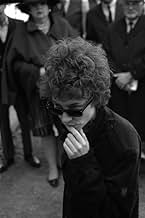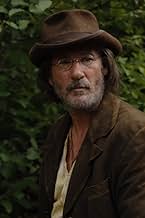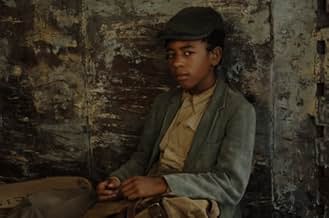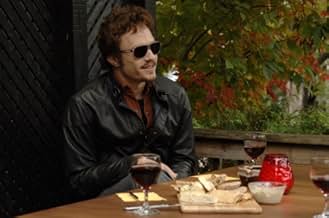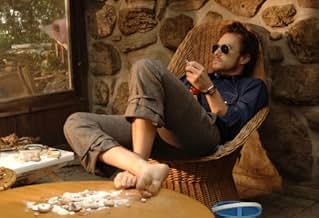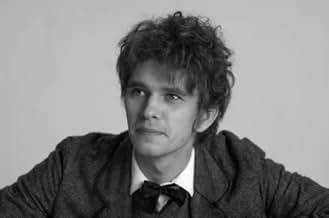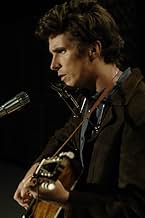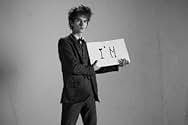I'm Not There
- 2007
- Tous publics
- 2h 15min
Des considérations sur la vie de Bob Dylan, à travers six personnages incarnant un aspect différent de la vie et de l'oeuvre du musicien.Des considérations sur la vie de Bob Dylan, à travers six personnages incarnant un aspect différent de la vie et de l'oeuvre du musicien.Des considérations sur la vie de Bob Dylan, à travers six personnages incarnant un aspect différent de la vie et de l'oeuvre du musicien.
- Réalisation
- Scénario
- Casting principal
- Nommé pour 1 Oscar
- 29 victoires et 49 nominations au total
- Hobo Moe
- (as Roc LaFortune)
- Circus Man
- (as Brian RC Wilmes)
Avis à la une
You need to know that the characters all represent different aspects of Dylan, and that even though they are "Dylan" they have different names. Some of the Dylan aspects are personified as a young black boy using the name Woody Guthrie, a woman, and a middle-aged Billy the Kidd, for example. And the film jumps from character to character and then back again, frequently.
Chances are, if you are not an art film aficionado, you won't care for this one. On the other hand, if you do your Dylan homework, you may very well enjoy it even though it isn't typical mainstream movie fare.
The much-publicised, overly re-hashed concept driving the film is this: Dylan is portrayed by six actors of different races, ages and genders, none of whom are named Dylan, but represent aspects of his personality and life story. Every art-house buff will squeal at this delightfully off-kilter concept (well, except that it's been done before) - but never used so cleverly I'll admit. But, the cleverness of the concept only remains clever if it is executed well. This is where most people have a problem with the film.
Most of what you may have read in reviews is correct. The film is challenging, borderline plot-less (unless you are generally acquainted with Dylan's life) and seems muddled (again, only if you don't have a general knowledge of his life). For anyone who can't grasp the basic, "each actor represents a stage etc." concept, this film will be lost on them completely... because it gets even more complicated! The film is so layered, with hidden in-jokes, and snippets of real quotes from songs and interviews with Dylan used as dialogue, and story lines within story lines. A great example is Heath Ledger's character: Ledger (an actor), plays an actor, playing Jack Rollins in a biopic, who is the representation of folk-singer-Dylan (a stage). An actor in a biopic playing an actor in a biopic about a singer representing Bob Dylan played by an actor in a biopic. The self-parody is just hilarious in this film.
To add to these 'layers', each actor's "stage" that they represent is filmed in a distinctive cinematic style, for example, the Cate Blanchett as Jude Quinn representing Bob Dylan sequence is shot in lush black and white. Haynes relishes this opportunity to show off, and he does. The film is stylistically stimulating, even if it does drag sometimes for ignoramuses like me who know literally nothing about Bob Dylan.
For those questioning the film's intentions as a biopic, I should think it was really obvious! The opening credits give a huge clue, as the main title comes up in stages: "I", "He", "I'm he", "I'm her", "Not her", "Not here", "I'm not there".
The film is like a dream: you come out of it with this vague (exact details in the film are scarce) and vivid impression of Dylan's personality, without learning anything. The title is certainly relevant - Haynes' actually conceals Dylan in this film! This biopic is conventional in the way it still presents a chronological life story if you arrange it all together and remember the actors represent one person, but it is different in the way it doesn't try to make a real person into a character for a film. This is really the only way to represent someone - by not.
This film is composed of stories and individual representations and metaphors that describe a person's life, their attitudes at points in time and aspects of their personality, but gives us nothing. Absolutely nothing.
So, if you're ready to put the level of effort and concentration required to appreciate and maybe like the film, go for it. But I was not prepared for this film and I wish I'd read a biography before I saw it. That said, not knowing anything did help in a way, as after we had several questions about events in the film and their basis in reality. After all, the trailer had told us that stories were exaggerated, fictionalised, imagined and true. It inspired me enough to look him up on Wikipedia (I know, such dedication!).
The performances are all generally good. Blanchett, Bale and Franklin impressed me the most. Blanchett only falls short because of her voice, but she has the accent correct, and she can't change her voice that much! She became more believable as the film progressed. Charlotte Gainsbourg is also quietly moving in her role as the neglected wife of Ledger's character.
My final opinion is that the film is well executed, but only once you've had time to ruminate on it, research Dylan and hear the director's thoughts on his own work. I read a great deal of reviews as well that helped me to understand (not that I didn't like the film initially; I liked it after I saw it anyway). Appreciation builds the more I learn about the film and the intricate connections between it and it's un-subject.
That said, should a film be this much hard work just to like? Not for some people, but for others, the effort is worth it. It does eventually pay off, but it's exhausting.
Jack (Christian Bale) is the Dylan who became a hit in Greenwich Village and went into the South and sang "The Ballad of Hattie Carroll" and other protest "folk songs,"-the high-profile "political" Dylan who spearheaded a movement and became famous with his brilliant early LP's. But Jack doesn't want to be typecast and "betrays" his adoring public and his lover and folksinging champion Alice (Julianne Moore), a Joan Baez stand-in seen in later "interviews." Jack disappears and his place is taken by Robbie (Heath Ledger), a young actor in New York who becomes famous for starring in a 1965 film depicting the vanished Jack. Robbie meets Claire (Charlotte Gainsbourg) in a Village coffee shop and falls in love, and a turbulent ten-year marriage follows, winding up painfully at the time of the Vietnam War's end.
If Jack represents the cast-off early style and Robbie represents Dylan's family life, Jude (Cate Blanchett) is Dylan the artist, quintessentially as seen in the mid-to-late Sixties when he toured England (an event notably chronicled by two Leacock-Pennebaker documentaries)-and shocked his audiences, some of whose members felt betrayed and shouted "Judas!", when he shifted from solo guitar and harmonica to more personal songs with loud rock accompaniment. Jude's segments are partly borrowed from Pennebaker, but largely consist of gorgeous black and white scenes deliberately and "churlishly" (Haynes' word) imitative of Fellini's 8 ½.
Jude's new style is admired by Allen Ginsberg (David Cross) and underground groupie Coco Rivington (Michelle Williams) and he becomes internationally famous. But he continues to be misunderstood by the protest music old guard and conventional journalists like the British TV host Mr. Jones (Bruce Greenwood)-who's incorporated into a music video for Highway 61 Revisited's "Ballad of a Thin Man": ". . .something is happening here /And you don't know what it is, do you, Mister Jones." . .
Jude and Arthur articulate the early Dylan's challenging, ironic stance to the public, but Jude is exhausted on tour and his nihilism leads him to an existential crisis.
He's reborn symbolically in Pastor John (Christian Bale again), who's moved to Stockton twenty years later and become a born-again preacher, singing his own gospel songs. Finally the last version of Dylan appears in Billy (Richard Gere), in full retreat from the world till threats to destroy his town of Riddle cause him to enter public life again. This sequence evokes a Sixties historical western in which Pat Garrett (Bruce Greenwood) is a character.
This is only the barest outline of the two-and-a-quarter-hour film, in which various "Dylan's" are woven in and out. Maybe the reason why I found Woody's sequences delightful and Billy's colorful but wearying has to do with the latter's coming two hours later. But Gere and his sequences evoke Dylan less well and are puzzling to interpret. Blanchett's in contrast are, of course, the most conventionally straightforward. She's the only one who successfully mimics the physical appearance and the speaking voice of the artist (unless Whishaw does a better job with the voice). But Blanchett's mimicry is intentionally undercut (and the biopic conventionality of films like Ray avoided) by having Jude be played by a woman-which was planned by Haynes in his screenplay before he even chose his actor.
The method Haynes has chosen avoids cliché. This is still a biopic, but it's a sophisticated one; and the fractured portrait is well justified by the nature of its subject. Dylan has always been a shape-shifter; some of his permutations were left out, such as the period of the orthodox Jew and JDL supporter. But it's intelligent to see Dylan the man, the husband, the artist, the political being, and the religious being as completely separate entities because no simple biopic sequence can really dramatize the complexity of such an artist and such a protean existence. Haynes' film makes you think about biography itself, as well as giving imaginative shape to aspects of Bob Dylan no non-fiction account can really provide.
Maybe it's the daringly experimental methodology that led Dylan himself, approached through his eldest son Jesse, to grant Haynes both the musical rights and the biographical rights. Haynes has chosen a multifaceted and original way of using Dylan's songs. Only Franklin actually performs them with his own voice. Otherwise the soundtrack mixes original Dylan recordings with existing covers, new ones by people as widely various as Ritche Havens, Iggy Pop, John Doe and Sonic Youth, and other music, including, appropriately for the 8 ½- esque sequences, Nino Rota. There is a voice-over narration by Kris Kristofferson. Haynes worked on the screenplay for years, and then collaborated with Oren Moverman.
Not for mainstream audiences or be prime Oscar bait, but a challenging, fun watch.
Shown in the press screenings of the New York Film Festival at Lincoln Center 2007. Haynes was present for a Q&A afterward with J. Hoberman of the Village Voice, which revealed that the director is an intelligent and articulate man who knows his Dylan.
Here’s one big problem right off the bat. The six various characters, each representing part of Dylan, have different names. Some of them are named after real-life people, like Woody Guthrie and Arthur Rimbaud. Some have fictitious names, like Jude Quinn (an amalgam of Jude from “Hey Jude” and Dylan’s own “The Mighty Quinn”), Jack Rollins, and Robbie Clark - the latter being an actor playing one of the aspects in a movie. And then it gets confusing.
The first gimmick for this movie is that each aspect is played by an actor you wouldn’t expect to see playing Dylan. Okay, maybe not all of them, but some of them. Cate Blanchett is one. She’s female, in case you were unsure, and she is by far the best Dylan in the movie. She plays Jude, the latter-day, peeved-at-everyone Dylan. Another is Marcus Carl Franklin, who plays “Woody Guthrie” - here, a young version of Dylan, riding the rails across the Midwest. Franklin is African American. Then there’s Heath Ledger and Christian Bale, who are Australian (as is Blanchett) and Welsh, respectively. The problem with those, though, is that the only difference between them and the real Dylan is Dylan’s particular linguistic tendencies, so you wind up with just some guys acting Dylanesque. You know, the perpetual cigarette dangling precariously, the hat, the whole nine yards.
It would have been more effective, for me, if each of the aspects was played by completely different looking people - because in order for them to be identifiable as Dylan, they would have to sound like him. Otherwise you’re left with some folk-singing iconoclast who’s rebelling against everyone, and you don’t know why. So there’s one issue. And that would have been a clever, but not too-clever, way for each supposed aspect or time period to be represented. Even if two aspects were on the screen simultaneously, big deal - at least we could tell who was who.
But added to this gimmick is the fact that some non-Dylan characters - and some situations - are based on real-life people, like Allen Ginsburg, and retain their counterparts’ names, and others are clearly supposed to be real people but have … different names. And some situations definitely did occur (such as Dylan’s getting booed at the Newport festival, a huge turning point for him), but did all of them? Were any of them made up to highlight that particular aspect of his personality? One of the characters is Arthur Rimbaud. No, not the poet, he just has that name. Anyway, the entirety of his screen time is spent giving testimony or something to officials (or a jury, I’m not sure). And his speeches are of the deep philosophical sort, the kind that Dylan was apparently fond of - ways to get into people’s minds, but I’m not sure what the soliloquies add in terms of exposition and revelation.
Then there’s also Richard Gere, who plays Billy the Kid, another “aspect” of Dylan. Apparently here Billy is mythologized as this hiding loner at the end of his career, just sort of like Dylan, only Dylan’s not even now at the end of his career, unless he keels over tomorrow, or something. Gere’s good, and I don’t say that often, but I think the aspect, such as it is, is too abstract and unreadable to be worthwhile.
The intermittent narrator (Kris Kristofferson) is marginally helpful; perhaps he could have been used to tie all these aspects together. Instead we get two hours of ego feeding and idol worship. To me, though, it felt more like idle worship than anything else, a waste of time even if you’re willing to grasp whatever deep insights the film pretends to offer to you.
Le saviez-vous
- AnecdotesTodd Haynes needed to get approval from Bob Dylan to use his music, since (unlike in his Velvet Goldmine (1998) where David Bowie did not give his permission for his music) he felt the film would not work without it. At the encouragement of Dylan's manager, Haynes wrote a one-page summary of his concept and the characters, which Dylan approved. It took another 6 years to get the film made due to funding difficulties.
- GaffesWhen Woody's character is first seen he is running towards a train going North but when he is sitting on the train, it is noticeably going South.
- Citations
Billy the Kid: People are always talking about freedom. Freedom to live a certain way, without being kicked around. Course the more you live a certain way, the less it feel like freedom. Me, uhm, I can change during the course of a day. I wake and I'm one person, when I go to sleep I know for certain I'm somebody else. I don't know who I am most of the time.
- Crédits fousThe way the title appears on the screen at the opening would read: I he I'm her not her not here. I'm not there" (period included).
- Bandes originalesGoin' to Acapulco
Performed by Jim James and Calexico
Written by Bob Dylan
Published by Dwarf Music (SESAC)
Produced by Joey Burns
Jim James appears courtesy of ATO Records
Calexico appears courtesy of Quarterstick Records
Meilleurs choix
Détails
- Date de sortie
- Pays d’origine
- Sites officiels
- Langue
- Aussi connu sous le nom de
- Mi historia sin mi
- Lieux de tournage
- Sociétés de production
- Voir plus de crédits d'entreprise sur IMDbPro
Box-office
- Budget
- 20 000 000 $US (estimé)
- Montant brut aux États-Unis et au Canada
- 4 017 609 $US
- Week-end de sortie aux États-Unis et au Canada
- 730 819 $US
- 25 nov. 2007
- Montant brut mondial
- 11 792 542 $US
- Durée2 heures 15 minutes
- Couleur
- Mixage
- Rapport de forme
- 2.35 : 1
Contribuer à cette page





